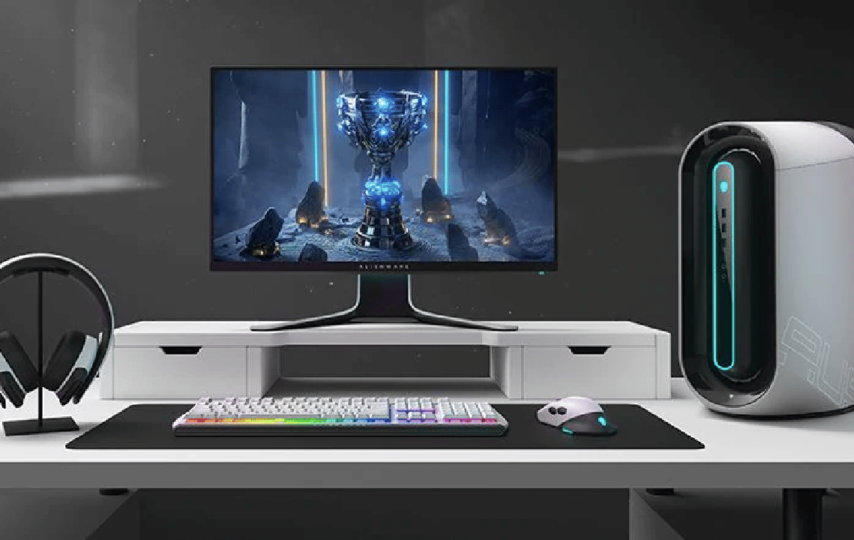Gaming PCs often differ from standard personal computers in that they typically have more powerful video cards, more powerful CPUs with a higher number of cores, and more powerful RAM. Gaming computers are also used for more intensive jobs like video editing.
This article will outline what special considerations need to be made when working with a gaming setup and how to identify the components of your computer so that you may avoid spending for an upgrade if you don’t have to. Before you start gaming, there might only be one or two bits of hardware that could use an upgrade, but you might discover that you’d need to replace almost everything or nothing before your PC is deemed game-ready.
You can thoroughly investigate each component on your own and design a custom build from scratch, or you can find a pre-made build online and modify it to fit your unique requirements.
To help you get started, bear in mind the following:
- Budget.
Before you begin choosing components, we strongly advise creating a budget. Upgrades to individual components are always possible.
- Compatibility.
Before making any purchases, create a build list. The compatibility of all components is required. The Gaming PC Bundle is quite helpful in terms of compatibility.
- System prerequisites.
Check the suggested system requirements for the game you want to play if you’re building this PC to play it and make your plans accordingly.
The components required to make a gaming computer are much the same as those required to build a standard PC:
- Motherboard
- Processor (CPU)
- Power supply (PSU)
- Storage drive (Hard drive or SSD)
- Memory (RAM)
- Graphics Card (GPU)
- Cooling fans/CPU cooler
All those components are present in even the most basic home or commercial computers. Possibly except for the graphics card, as many computers now come with on-board video processing instead of discrete video cards. Nevertheless, even then, some still have one if they need to drive multiple screens, for example.
So, what distinguishes a gaming PC from a conventional computer if they both share similar parts? It should come as no surprise that the two types of PCs differ in their component strength and performance. Because high-end desktops will be able to play games and may have the same characteristics as a good inexpensive gaming PC, this is unquestionably a tricky issue. A high-end PC with the finest of the best components may include components more commonly seen in a workstation.
The main components to consider while examining a computer’s specifications to see if it will be able to run the newest games. These things will make or break a system’s performance.
Now let’s examine how each component works, why it is essential, and what to look for when comparing products.
- The Motherboard
The motherboard of the computer is a key component when thinking about a gaming PC. Many individuals start with the motherboard when building their gaming PC or purchasing one that has been custom-built. The motherboard is where your computer’s hardware is located. The compatibility of a motherboard with the components you select is crucial, but they can also include integrated graphics cards, Wi-Fi systems, and other features.
Since it connects everything, the motherboard serves as the computer’s main circuit board. The motherboard and CPU must be compatible for this to work, and every other component, including the wireless cards, hard drives, RAM, and optical discs, integrates into the motherboard.
One course of action to cut down your motherboard choices available is to shop by size. The most popular form factors are Extended ATX, ATX, microATX, and Mini-ITX.
- The largest motherboards are Extended ATX models, which measure 12 by 13 or 12 by 10.1 inches and frequently contain eight RAM slots (for up to 128GB of RAM).
- ATX motherboards have a maximum of four RAM slots and are only somewhat smaller (12 by 9.6 inches).
- The maximum number of RAM slots on microATX motherboards (9.6 by 9.6 inches) is four.
- The smallest of the four form factors, mini-ITX motherboards measure 6.7 by 6.7 inches and frequently contain two RAM slots.
Size is not the only consideration. Both for your current setup and any future hardware upgrades, your motherboard must be compatible with the components you’ll attach to it. (The Gaming PC Bundle tool may be useful.)
Selecting a motherboard that is big enough to accommodate both existing and future hardware is crucial because all the components plug into it.
The advantage of supporting the most recent, cutting-edge standards and technology is found in newer motherboards. For instance, some Intel® 600-Series Chipsets feature potent next-generation components including integrated Intel® KillerTM Wi-Fi 6E, PCIe 5.0 graphics, and DDR5 RAM.
These days, a lot of gamers choose the Intel Z690 chipset. One of the newest chipsets that support Intel Skylake processors, the Z690 chipset enables two characteristics that are particularly desired in a good gaming PC: overclocking and DDR5. While DDR5 enables the use of more recent, faster RAM modules, overclocking allows you to directly increase the processor’s speed. A common option is the B660 chipset, but these motherboards have fewer PCIe lanes.
- The Processor
The central processing unit, or CPU, is what powers your computer. The CPU transfers instructions from one system to another in your computer. It has an impact on all aspects of your experience, such as gaming, streaming, content production, and multitasking. The faster it can transport data for both software and hardware operations, the better the processor.
When building a gaming computer, selecting the proper CPU is important. Even though games are typically more GPU-intensive, the CPU is still essential to the system’s overall performance. For a low-cost gaming PC, a CPU with 4 cores will do. Top-end gaming computers frequently include i5 or i7 processors with up to 8 cores. A dual-core processor is an option if your budget is on the tighter side, but gaming performance may suffer.
The Intel Core i5 processor appears to hit the sweet spot of price and power for the majority of gaming applications. Models of processors that end in K, such as the Core i5-12600K and Core i7-12700K, are unlocked and can be overclocked if the right motherboard is used.
The processor is one of the most difficult components to upgrade, although memory, storage, and graphics cards are straightforward. When looking for a gaming PC, it is typically advised to buy the greatest processor you can afford so that your system can last for many years even as you change the other components of it.
Look for an Intel® CoreTM processor with a high Max Turbo Frequency (MTF), which defines the fastest clock speed it can achieve utilising Intel Turbo Boost technology, as well as a high number of cores and threads when choosing a CPU for gaming. Performance can be significantly impacted by both factors.
So key points to remember:
- A CPU with a high maximum turbo frequency performs exceptionally well in single-threaded performance, enhancing your frame rate in demanding games.
- Meanwhile, additional cores and threads let you perform more at once, keeping your system responsive when you switch between various apps such as your game, Discord, and streaming studio software. Additionally, they support multithreaded rendering in games like Valorant1 and Fortnite, as well as titles like Minecraft that have a lot of geometry.
- There are many different core configurations for processors, including dual-core (2), quad-core (4), Hexa-core (6), octa-core (8), etc. A quad-core or Hexa-core CPU performs effectively in multi-threaded programmes if you need a high-performance system. Programmers and engineers who work on video games frequently employ octa-core processors.
- Processor speeds vary based on model and voltage, but in general, you want one that runs at a minimum of 2.0 GHz, however, 3.0 GHz and 4.0 GHz are even better, to minimise bottlenecking.
- The Memory
The amount of data that your computer can process at any given time is determined by RAM (random access memory). RAM is where your computer keeps the data it needs to access immediately. The more RAM your computer has, the more quickly it can handle a lot of data – useful for work; necessary for gaming.
It’s crucial to have enough RAM for a PC to function properly, but it’s not necessary to go crazy in this area.
A typical computer that isn’t used for gaming can likely get by with 4 GB or even less system memory. A gaming PC, meanwhile, might need 8 GB or more RAM. Actually, some motherboards can store enormous quantities of memory, like 128 GB, giving you essentially limitless alternatives. You can add more RAM to certain systems.
A true gaming computer should have at least 16GB of DDR5 RAM to run anything that is thrown at it, while 32GB is ideal for streaming and multitasking while gaming. DDR5 RAM is a reasonably affordable upgrade. Even while you can always choose more, gaming performance won’t necessarily improve. Although you’ll be able to run multiple programmes simultaneously, your video game will already perform worse if it must use system memory rather than the graphics card’s dedicated video memory (VRAM). When overclocking, gamers frequently choose fast RAM, but the added performance for the money simply isn’t there.
Although it is safe to assume that most video games require 12 GB of memory or less, you should still read the “system requirements” listed next to any games you download or buy.
You’ll want at least 16GB of RAM for gaming as of 2022. You’ll require more if you intend to run numerous concurrent tasks, such as streaming your game or substantially customising it.
What your motherboard and CPU can support is the most crucial consideration when buying RAM. RAM that is faster than what your system can handle will slow down to operate within the limits of your system.
Look for RAM that supports Intel® Extreme Memory Profile (Intel® XMP) if you opt to go with high-speed RAM. Without being overclocked4, high-speed RAM will operate at a regular speed. Thanks to Intel® XMP’s tested and predefined profiles, overclocking high-speed RAM is simple.
There is a very significant probability that a video game simply won’t operate smoothly, or perhaps at all if you only have 8 GB of RAM and it requires 16 GB unless you upgrade to make up the 8 GB difference. A minimal and recommended memory size, such as 6 GB minimum and 8 GB suggested, is common for PC games.
To determine how much RAM your computer needs for the majority of your favourite games, do some research before you start shopping and use that information as a reference.
- The GPU
The GPU (graphics processing unit), essentially the most vital component of a gaming setup, generates images from your PC and displays them on your monitor. More powerful GPUs enable improved in-game graphics and settings.
A specialised graphics card is the sole feature that distinguishes gaming computers from other computers. It’s useful to avoid using low-end cards in this area because it’s where your gaming performance will increase the most. Today’s market offers a huge variety of graphics cards, ranging from extremely expensive multi-GPU solutions to low-cost models.
We advise you to spend roughly one-third of your overall budget on the greatest graphics card you can afford. We advise at least an Nvidia GTX 3060 or AMD Radeon RX 6600 for a mid-range card that strikes a decent balance between cost and performance. Even if you can play games on less expensive cards, there will be a noticeable performance hit. The lowest GPU required to experiment with virtual reality is a GTX 3070, however, these days we strongly advise a GTX 3070.
If you’re just getting started with PC gaming, search for a graphics card that supports DirectX 11(DirectX 12 is even better) and at least has GDDR3 video RAM (GDDR5 or GDDR6 is even better). Most video cards—if not all—offer these features.
The PCIe x16 slot on your PC’s motherboard is where discrete graphics cards, like an Intel® ArcTM A-series GPU, are plugged in. These big, strong components are discrete graphics cards. Anyone who wants to play demanding, graphically intensive games needs a GPU, which directly affects your in-game FPS together with the CPU.
Ray tracing and XeSS upscaling, which upscales 1080p resolution to 4K, are further advanced rendering techniques that Intel® ArcTM A-series GPUs are capable of executing. These techniques create high graphics with efficient performance.
While researching GPUs for your build, read up on benchmark results online or the suggested system requirements for some forthcoming titles you’d like to play before making your decision.
- Hard Drive
There are primarily two types of PC storage: hard drives and solid-state drives (SSDs) (HDDs). It is where files are kept when not in use. As long as a video game is installed on your computer, it will take up space on your hard drive. Larger drives offer greater storage space, which refers to more space for files, games, media, and other items.
Each has advantages and disadvantages, but the good news is that you don’t have to pick one over the other.
Most likely, your build should include an SSD. Some contemporary games have started to require them because they are much quicker and less likely to have a mechanical problem than HDDs. SSDs come in two different protocols:
- Serial Advanced Technology Attachment (SATA), an outdated standard that has lower peak bandwidth and higher latency than the other two.
- Non-Volatile Memory Express (NVMe), which boosts performance by utilising the PCIe interface.
While traditional hard disc drives (HDD) are slower, solid-state hard drives (SSD) are also more expensive per gigabyte. Desktop PCs benefit from SSDs as well since they provide quicker start-up times and faster file transfers.
An HDD might be a good addition to your build. Due to HDDs’ low price and great storage capacity, you may store significant amounts of data for a reasonable cost. HDDs have two different form factors:
- 2.5 inches, which are more frequently seen in laptops and typically rotate at a speed of 5400 RPM (revolutions per minute)
- 3.5 inches, which are more prevalent in desktops and spin more quickly—often at speeds of more than 7200 RPM.
You are not required to choose just one kind of storage. For maximum storage capacity, many individuals utilise their little SSD as the boot drive (for the operating system, games, and other programmes) and fill the remaining bays with less expensive HDDs.
While the average computer user may be perfectly content with, say, 250 GB of hard drive capacity, or even less, you should think twice before using that little space for gaming.
For instance, you might discover that the video game you wish to download needs about 50 GB of hard disc space. You instal it, download a few in-game upgrades, and then you download some patches, so now you’re looking at 60 or 70 GB for just one game.
At that pace, 350 GB would be required if you wanted to store just five video games on your PC.
This is why having a large hard disc for your gaming PC is essential. You don’t have to worry about throwing out your current hard drive and upgrading to a brand-new, really large one because the majority of desktop computers can sustain two or even three hard drives. Just instal another drive in addition to your main one.
SSDs, on the other hand, which don’t have any moving parts, retrieve and deliver data even more quickly. Even though SSDs are still pricey, purchasing one could improve your quality of life.
- Gaming PC Cases
You should have a case, or at the very least, the size of the case, in mind before you begin choosing the components.
The most important consideration when selecting a case is where you intend to place the computer. The eventual location of your PC will decide how big you can (or cannot) go and whether or not specific premium case features are worthwhile spending extra money on.
If the computer will be buried under your desk, for instance, you probably don’t want to spend the money on a tempered glass side panel.
The three sizes of cases are full-tower, mid-tower, and mini-tower. Despite being based on motherboard size, these are fairly broad categories.
- Full-tower cases are built to accommodate both Extended-ATX and normal full-size ATX motherboards. They often have dimensions of more than 8 inches in width, 18 to 20 inches long, and 22 to 24 inches in height. If you wish to use an Extended-ATX motherboard, instal a large cooling system, or add more storage, you’ll probably need a full-tower case (although some mid-tower cases do accept Extended-ATX motherboards). However Mini-ITX motherboards can also fit in full-tower cases, there are no obvious benefits to organising a system that way.
- Mid-tower cases are made to accommodate typical full-size ATX motherboards. In general, mid-tower is the most typical case size. These cases’ sizes can vary considerably, but they often fall between 18 and 20 inches tall, 17 to 20 inches long, and 6 to 8 inches wide. These cases often have enough space for a gaming setup that includes many hard drives, a few graphics cards, and a basic cooling system.
- Mini-tower cases, also known as small form factor (SFF) builds, are small and built to accommodate a variety of smaller motherboards, such as mini-ITX motherboards. Particularly mini-towers using mini-ITX motherboards, necessitate substantial organisation and cable management, so your build and cooling system will need to be precisely planned. Additionally, you might need to employ parts designed especially for compact constructions, and bear in mind that there won’t be much place left over for upgrades once the build is complete. SFF projects, though not advised for new builders, can be a great challenge once you’ve completed one or two systems.
Finding a case that meets your budget shouldn’t be too difficult because all case sizes are offered at various price points. Although more expensive cases may offer premium features and conveniences like noise reduction, better construction materials, detachable drive cages, and more aesthetically pleasing cable management, these improvements often have no obvious performance impact.
When you’ve decided how large you would like to go, look for a case that fits that specification. If you’re unsure of the size you want, it’s best to take a little bit of caution. You’ll probably discover that working with a larger case is simpler, and you’ll have an easier time updating your PC in the future.








